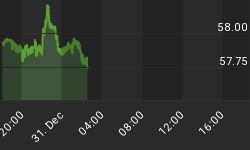The prevailing notion among the main stream media and economists is that interest rates are rising because of improving economic growth. But like many of the readily accepted tenets of today's world of popular finance, this too has its basis in fallacy.
Interest rates have increased by nearly 40 basis points on the Ten year note since the first week of March and that is being offered as proof that the economy has healed and GDP growth is about to accelerate. But in truth, the recent spike in Treasury bond yields is only the result of a temporary ebbing in the fear trade that brought about panic selling in Euro denominated debt, which had previously caused U.S. Treasury prices to soar.
The head of the European Central Bank, Mario Draghi, just finished printing over a trillion Euros in an effort to calm the bond market. This new liquidity predictably found its way into distressed Eurozone debt and has mollified bond investors; for the moment. Since a Greek exit from the Euro in no longer perceived an imminent threat, investors have sold their recent purchases of U.S. Treasuries and piled back into Eurozone sovereign debt. For example, the yield on the Italian 10 year note took a rollercoaster ride above 7% at the start of this year, before plunging south of 5% by the beginning of March.
However, in contrast to what passes for the economic wisdom of today, an increase in the rate of sovereign bond yields would be a function of deterioration in their credit, currency and inflation risks. But it would never be because of an increase in the prospects for growth. An economy that is experiencing a healthy growth spurt would experience a reduction in all three of those factors that would cause bond yields to rise. Strong GDP growth--which results from increased productivity--serves to improve credit risk, due to a bolstered tax base, while it also lowers the rate of inflation by increasing the amount of goods and services available for purchase. Therefore, it also tends to boost the currency's exchange rate as well.
Economic growth that is also accompanied by a sound monetary policy tends to lower the rate of inflation and thus increases the real rate of interest. But it does this without increasing nominal interest rates. It instead serves to provide a higher real rate of return on sovereign debt ownership.
This is precisely what occurred in the U.S. during the early 1980's. After Fed Chairman Paul Volcker fought and won the battle against inflation, economic growth exploded while the stock market soared in value. And nominal bond prices began to fall, not rise. At the start of the 1908's, GDP fell by 0.3%, the Ten year note was 12% and the rate of inflation was 14%. Therefore, real interest rates were a negative 2% at the start of that decade. But by 1984 GDP had accelerated to 7.2% in that year. However, the nominal Ten year note fell to 11% and inflation had plummeted down to 4%. In this classic example that illustrates clearly how growth isn't inflationary; real interest rates soared by 9 percentage points to yield a positive 7% return on sovereign debt! In a healthy economy; stocks, bond prices and the currency should all rise together as nominal yields fall and real interest rates rise. The simple truth is that the rate of inflation should fall faster than the rate nominal yields decrease.
However, what the Fed, ECB and BOJ are doing now provides a prescription for soaring nominal interest rates in the not too distant future. These central banks are violating all three conditions that lead to low and stable interest rates for the long term. By massively increasing the money supply, they have caused inflation to rise and reduced the purchasing power of their currencies. And by creating superfluous money and credit, the central banks have given the cover needed for their respective governments to run up an overwhelming amount of debt. The currency, credit and inflation risk of owning those three sovereign debt markets has soared. Therefore, they have created the perfect conditions for a collapse of their bond markets.
Central bankers believe they have more power and influence over the yield curve than what they indeed posses. The fact is they can only control interest rates for a relatively short period of time. By not allowing interest rates to function freely, the Fed, ECB and BOJ are facing the eventuality of a bond market debacle that will also crush their currencies and stock markets. Recent history has proven that these central banks will fight the ensuing run-up in yields with QEs III, IV and V in an effort to postpone the pain. This failure to acknowledge reality will cause the eventual collapse to become significantly more acute.
















